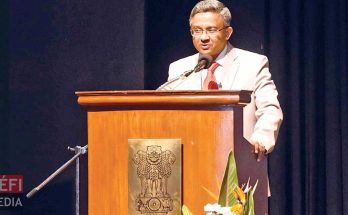 It’s a journey that could prove to be path-breaking in mapping new horizons in the age-old India-Nepal relations. In her second stand-alone visit to a neighbouring country in South Asia, India’s External Affairs Minister Sushma Swaraj travels to Kathmandu July 25-27, an important trip that promises to usher in a new chapter between the two fraternal neigbours bound by deep ties of geography, nature, history and culture. The visit underscores yet again the primacy of South Asia in the foreign policy calculus of the new government in New Delhi and comes nearly two months after Prime Minister Narendra Modi hosted the leaders of SAARC countries for his swearing-in ceremony and a month after Mrs Sushma Swaraj visited Dhaka.
It’s a journey that could prove to be path-breaking in mapping new horizons in the age-old India-Nepal relations. In her second stand-alone visit to a neighbouring country in South Asia, India’s External Affairs Minister Sushma Swaraj travels to Kathmandu July 25-27, an important trip that promises to usher in a new chapter between the two fraternal neigbours bound by deep ties of geography, nature, history and culture. The visit underscores yet again the primacy of South Asia in the foreign policy calculus of the new government in New Delhi and comes nearly two months after Prime Minister Narendra Modi hosted the leaders of SAARC countries for his swearing-in ceremony and a month after Mrs Sushma Swaraj visited Dhaka.
Close and intimate ties
Perhaps no two neighbours have such close and intimate ties, which are rooted in history and manifest in day-to-day existence in a thousand different ways. The facts and figures tell their own story, and evoke a rich tapestry of relations framed by trade and investment, culture and robust people-to-people contacts. Indians and Nepalese bond and merge so effortlessly that they are hardly seen as foreigners in each other’s country. There are six million Nepalese working in India. And there are 600,000 Indians who have made Nepal their home. Nepalese can work in India without a work permit, open bank accounts and own property.
Open border has ensured an uninterrupted flow of flow of people between the two countries. Besides, there are 60 flights per week between the two countries. Twenty per cent of all tourists visiting Nepal are from India, and around 40 per cent of tourist flows to Nepal are through India.
Interlinked economic destinies
The imperatives of geography and history have resulted in an intertwining of the economic fortunes of the two neighbours. Two-thirds of Nepal’s foreign trade is with India, with bilateral trade estimated to be around USD 4.7 billion. India accounts for 47 per cent of foreign direct investment in Nepal. The trade treaty, which was revised in 1996, has proved to be a pivotal point in economic relations between the two countries. Since 1996, Nepal’s exports to India have burgeoned more than eleven times and bilateral trade more than seven times. Indian firms are the biggest investors in Nepal, accounting for about 40% of total approved foreign direct investments. There are about 150 operating Indian ventures in Nepal which encompass diverse sectors, including manufacturing, services (banking, insurance, dry port, education and telecom), power sector and tourism industries. Top Indian investors in Nepal, among others, include ITC, Dabur India, Tata Power, Hindustan Unilever, VSNL, TCIL, MTNL, State Bank of India, Punjab National Bank, Life Insurance Corporation of India and Asian Paints.
Joint Commission
Against this backdrop of multi-layered relations, India’s foreign minister will co-chair the joint commission with her Nepalese counterpart Mahendra Bahadur Pandey in Kathmandu July 26. The importance of the meeting can be gauged from the fact that this will be the first joint commission meeting in 23 years and will encompass five clusters of issues, including I) Political, security and border issues II) Economic cooperation and infrastructure III) Trade and transit IV)Power and water resources V) Culture, education and media. Signalling the importance of the talks and given a wide array of issues on the table, the minister will be accompanied by officials from the ministries of external affairs, power, water resources, commerce, road transport, railways, human resources development, and culture. Besides chairing the Joint Commission meeting, the minister will also call on Nepal’s President Ram Baran Yadav, Prime Minister Sushil Kumar Koirala, and a cross section of the political leadership in Nepal across the entire spectrum.
Given the scope of the joint commission, one can safely say that the entire spectrum of bilateral issues will be discussed at the talks. Issues relating to revision of the 1950 Treaty of Peace and Friendship, which forms the bedrock of the India-Nepal relations, are expected to figure in the discussions. The treaty is seen as unfair by some sections of the Nepalese political establishment, a charge denied by India, but New Delhi has indicated its willingness to be receptive to concrete suggestions from the Nepalese side.
Deepening security and counter-terror cooperation is another important priority for India. In this context, the security agencies of the two countries have been proactively cooperating across a wide swathe of areas, including tackling illicit smuggling, arms-trafficking and fake currency. Given porous borders and reports of militants using the India-Nepal border as a conduit, the security dimension of the relationship is set to bolstered in days to come.
Hydropower: Co-creating prosperity
 Most important, the focus will be on fructifying the potential of hydropower cooperation, which has remained untapped largely due to differing perceptions. At the talks, India is hoping to clinch a new power agreement that open new vistas of win-win opportunities in this sector. If the deal goes through, it could prove to be a game-changer for Nepal’s chronic power woes, and India, too, will get surplus electricity as part of the bargain. Nepal, according to experts, have 40,000 MW of hydel power that has been found to be technically and financially viable. The total hydel potential is estimated to be 75,000 MW. If Nepal’s hydropower potential is harnessed optimally, it has the potential to become the richest country in South Asia.
Most important, the focus will be on fructifying the potential of hydropower cooperation, which has remained untapped largely due to differing perceptions. At the talks, India is hoping to clinch a new power agreement that open new vistas of win-win opportunities in this sector. If the deal goes through, it could prove to be a game-changer for Nepal’s chronic power woes, and India, too, will get surplus electricity as part of the bargain. Nepal, according to experts, have 40,000 MW of hydel power that has been found to be technically and financially viable. The total hydel potential is estimated to be 75,000 MW. If Nepal’s hydropower potential is harnessed optimally, it has the potential to become the richest country in South Asia.
Development Partnership
Another important area that will be emphasised in the talks will be widening the scope of development partnership. India has underlined its commitment many a time to inclusive development of the Himalayan state and has already extended two lines of credit (LoC) of USD 100 million and USD 250 million, to the government of Nepal.
The development partnership spans a wide arc, with India building highways, bridges, optical fibre links, medical colleges, trauma centres, polytechnics, schools, hospitals and health centres. For river training and embankment construction, the Indian government has been generous with funds and expertise for strengthening and extension of embankments along Lalbakeya, Bagmati and Kamla rivers. Besides, there is a second EXIM Bank Line of Credit for $250 million and another $125 million for the power transmission line upgrades. Around 450 Small Development Projects being undertaken in various Districts of Nepal have done a world of good to ordinary Nepalese people. “There are remarkable success stories of some of these projects. When we started the Goitre Project,that was to rid Nepal of goitre. In 1985 the incidence of goitre in Nepal was approximately 44 per cent. In 2007 when we completed that project, it came down to 0.4 per cent,” says Syed Akbaruddin, the spokesperson of India’s foreign office. In the area of training, 3,000 Nepalese are provided scholarships by India annually.
New Horizons
 The meeting of joint commission is happening amid the flux in Nepal’s political landscape, with the constitution-making process getting a new lease. India has maintained a well-thought out policy of keeping away from internal affairs of Nepal, but in the spirit of friendship has consistently advocated an inclusive political process to establish durable peace and stability in the Himalayan state, which is navigating its journey towards modernity and national renewal on its own terms. In his meeting with Prime Minister Koirala in Delhi May 27, Prime Minister Narendra Modi glowingly described Nepal as “an old and deeply valued friend” and conveyed his sincere hope that the Constitution would be adopted in the one-year time-frame that Nepal had set for itself.”
The meeting of joint commission is happening amid the flux in Nepal’s political landscape, with the constitution-making process getting a new lease. India has maintained a well-thought out policy of keeping away from internal affairs of Nepal, but in the spirit of friendship has consistently advocated an inclusive political process to establish durable peace and stability in the Himalayan state, which is navigating its journey towards modernity and national renewal on its own terms. In his meeting with Prime Minister Koirala in Delhi May 27, Prime Minister Narendra Modi glowingly described Nepal as “an old and deeply valued friend” and conveyed his sincere hope that the Constitution would be adopted in the one-year time-frame that Nepal had set for itself.”
The July 25-27 visit by India’s foreign minister is, therefore, bristling with rich possibilities and could set the stage for a substantive visit by India’s Prime Minister Modi to Kathmandu soon. The prime ministerial visit, when it happens, could be a defining moment in pitching the India-Nepal relation onto a higher trajectory and open up numerous new vistas of multifarious win-win opportunities, bringing the two neighbours closer in a web of co-prosperity.
(Manish Chand is Editor-in-Chief of India Writes Network, www.indiawrites.org, a portal and e-journal focused on international affairs and the India Story. Follow him on twitter@scepticcryptic)
Author Profile

- Manish Chand is Founder-CEO and Editor-in-Chief of India Writes Network (www.indiawrites.org) and India and World, a pioneering magazine focused on international affairs. He is CEO/Director of TGII Media Private Limited, an India-based media, publishing, research and consultancy company.
Latest entries
 India and the WorldMarch 3, 2024India-Denmark Connect: Red carpet for Indians to Red Sea cooperation
India and the WorldMarch 3, 2024India-Denmark Connect: Red carpet for Indians to Red Sea cooperation India and the WorldFebruary 17, 2024Munich Security Conference: Jaishankar, Blinken focus on Red Sea, Middle East
India and the WorldFebruary 17, 2024Munich Security Conference: Jaishankar, Blinken focus on Red Sea, Middle East India and the WorldFebruary 14, 2024Munich Security Conference report: Migration, war top security threats
India and the WorldFebruary 14, 2024Munich Security Conference report: Migration, war top security threats India and the WorldJanuary 23, 2024With “Ram to Rashtra” mantra, Modi consecrates Ram temple for national renewal
India and the WorldJanuary 23, 2024With “Ram to Rashtra” mantra, Modi consecrates Ram temple for national renewal







